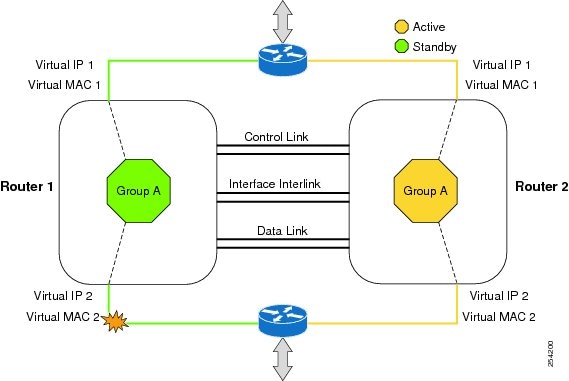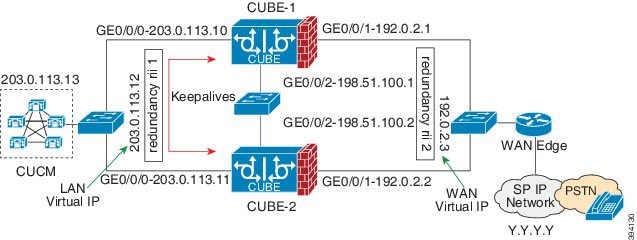About CUBE High Availability on Cisco 4000 Series ISR and Cisco Catalyst 8000 Series Edge Platforms
CUBE supports Box-to-box redundancy on Cisco 4000 Series Integrated Services Router (Cisco 4000 Series ISR), Cisco Catalyst 8300, 8200, and 8200-L Series Edge Platforms, and uses Redundancy Group Infrastructure to provide High Availability.
Box-to-Box Redundancy
Box-to-box redundancy enables configuring a pair of routers to act as back up for each other. In the router pair, the active router is determined based on the failover conditions. The router pair continuously exchange status messages. CUBE session information is checkpointed across the active and standby router. This enables the standby router to immediately take over all CUBE call processing responsibilities when the active router becomes unavailable.
Redundancy Group (RG) Infrastructure
A group of redundant interfaces form a Redundancy Group. The active and standby routers are connected by a configurable control link and data synchronization link. The control link is used to communicate the redundancy state for each router. The data synchronization link is used to transfer stateful information to synchronize the stateful database for the calls and media flows. Each pair of redundant interfaces is configured with the same unique ID number, also known as the Redundancy Interface Identifier (RII).
A Virtual IP address (VIP) is configured on interfaces that connect to the external network. All signaling and media is sourced from and sent to the Virtual IP address. External devices such as Cisco Unified Communication Manager, uses VIP as the destination IP address for the calls traversing through Cisco UBE.
The following figure shows the redundancy group configured for a pair of routers with a single outgoing interface.

Network Topology
This section describes how to configure the following network topology. PSTN access uses an Active and Standby pair of routers in a SIP trunk deployment between a Cisco Unified Communications Manager (Unified CM) and a service provider SIP trunk.


In this topology, both Active and Standby routers have the same configuration and connects through a physical switch across same interfaces. The topology is mandatory for the CUBE High Availability (HA) to work. For example, the CUBE-1 and CUBE-2 interface toward WAN must terminate on the same switch. Use Multiple interfaces or subinterfaces on either LAN or WAN side. Also, one CUBE has a lower IP address across all three interfaces on the same CUBE paltform.
We recommend that you keep the following in mind when configuring this topology:
-
Connect the redundancy group control and data interfaces in the CUBE HA pair to the same physical switch to avoid any latency in the network.
-
The RG control and data interfaces of the CUBE HA pair can be connected through a back-to-back cable or using a switch as shown in figures Network Topology with switch between active and standby routers and Network Topology with crossover cable between active and standby routers. However, it is recommended to use Portchannel for the RG control and data interfaces for redundancy. A single connection using back-to-back cable or switch presents a single point of failure due to a faulty cable, port, or switch, resulting in error state where both routers are Active.
-
If the RG ID is the same for the two different CUBE HA pairs, keepalive interface for check-pointing the RG control and data, and traffic must be in a different subnet or VLAN.

Note
This recommendation is applicable only if you connect using a switch, not by back-to-back cables.
-
You can configure a maximum of two redundancy groups. Hence, there can be only two Active and Standby pairs within the same network.

Note
This recommendation is applicable only if you connect using a switch, not by back-to-back cables.
-
Source all signaling and media from and to the virtual IP address.
-
Always save the running configuration to avoid losing it due to router reload during a failover.
-
Virtual Routing and Forwarding
-
Define Virtual Router Forwarding (VRF) in the same order on both Active and Standby routers for an accurate synchronization of data.
-
You can configure VRFs only on the traffic interface (SIP and RTP). Do not configure VRF on redundancy group control and data interface.
-
VRF configurations on both the Active and Standby router must be identical. VRF IDs checkpoints for the calls before and after switchover (includes VRF-based RTP port range).
-
-
Manually copy the configurations from one router to the other.
-
Replicating the configuration on the Standby router does not commit to the startup configuration; it is the running configuration. You must run the write memory command to commit the changes that are synchronized from the Active router on the Standby router.
Considerations and Restrictions
The following is a list of further considerations and restrictions you should know before configuring this topology:
Considerations
-
Checkpoint only active calls (Calls that are connected with 200 OK or ACK transaction completed).
-
When you apply and save the configuration for the first time, the platform must be reloaded.
-
For H.323 calls, media preservation is supported after the failover, but session signaling is not preserved.
-
If you have Cisco Unified Customer Voice Portal (CVP) in your network, we recommend that you configure TCP session transport for the SIP trunk between CVP and CUBE.
-
Upon failover, the previously active CUBE reloads by design.
-
CUBE uses the virtual IP address to communicate Smart Licensing information.
-
For SIP-SIP TLS calls, configure both the active and standby CUBE as trust points to a common external CA Server.
-
TCP sessions are not preserved during the failover. However, the signaling state at SIP layer is still preserved. Remote user agents must reestablish the TCP sessions (using port 5060) before sending subsequent messages.
-
Call Admission Control (CAC) state is maintained through switchover. After Stateful Switchover, no calls are allowed if the CAC limit is reached before the switchover.
-
Up to six multimedia lines in the SDP are checkpointed for CUBE high availability. From Cisco IOS XE Release 3.17 onwards, SDP Passthru (up to two m-lines) calls are also checkpointed.
-
Survivability.tcl preservation is supported from Cisco IOS XE Release 3.17 onwards for Unified Customer Voice Portal (CVP) deployments.
-
SRTP-RTP, SRTP-SRTP, and SRTP Passthru are supported.

Note
Redundancy control traffic that is exchanged between CUBE-1 and CUBE-2 is not secured natively and displays SRTP encryption keys in cleartext. If SRTP is used, you must secure this traffic by configuring a transport IPsec tunnel between the two interfaces that are used as the redundancy control link.
-
Set the port channel configuration to match upstream switches to prevent the device from entering standby mode unexpectedly.
-
Port channel is supported for both RG control data and traffic interfaces only from Cisco IOS XE 16.3.1 onwards.
Figure 5. Additional Supported Options for CUBE HA 
Restrictions
-
IPv6 is not supported.
-
All SCCP-based media resources (Conference bridge, Transcoding, Hardware MTP, and Software MTP) are not supported.
-
Cisco Unified Survivable Remote Site Telephony (Cisco Unified SRST) or TDM Gateway colocation on CUBE HA is not supported.
-
Routers connected through Metropolitan Area Network (MAN) Ethernet regardless of latency are not supported.
-
Out-of-band DTMF (Notify or KPML) is not supported post switchover. Only rtp-nte to rtp-nte and voice-inband to voice-inband DTMF works after the switchover.
-
Media-flow around and UC Services API (Cisco Unified Communications Manager Network-Based Recording) are not supported.
-
You cannot terminate Wide Area Network (WAN) on CUBE directly or Data HA on either side. Both active and standby routers must be in the same Data Center and connected to the same physical switch.
-
The Courtesy Callback (CCB) feature is not supported if a callback was registered with Cisco Unified Customer Voice Portal (CVP) and then a switchover was done on CUBE.
-
You cannot configure a secondary IP address for the interfaces.
-
If the redundancy group ID is same for the two different CUBE HA pairs, then the keepalive interface that is used for checkpointing RG control and data traffic must be in a different subnet or VLAN.
-
Call Progress Analysis (CPA) calls (before transferred to the agent), SCCP-based media resources, Noise Reduction, Acoustic Shock Protection (ASP), and transrating calls are not supported.
-
The failover time for a Box-to-box application is higher than the Inbox application.
-
One CUBE must have lower IPs across all the three interfaces on the same CUBE platform. For instance, CUBE-1 must have lower IP addresses in Gig0/0/0 interface compared with CUBE-2 Gig0/0/0 interface.
-
CUBE box-to-box high availability requires same priority and threshold to be configured on both CUBE-1 and CUBE-2.

 Feedback
Feedback